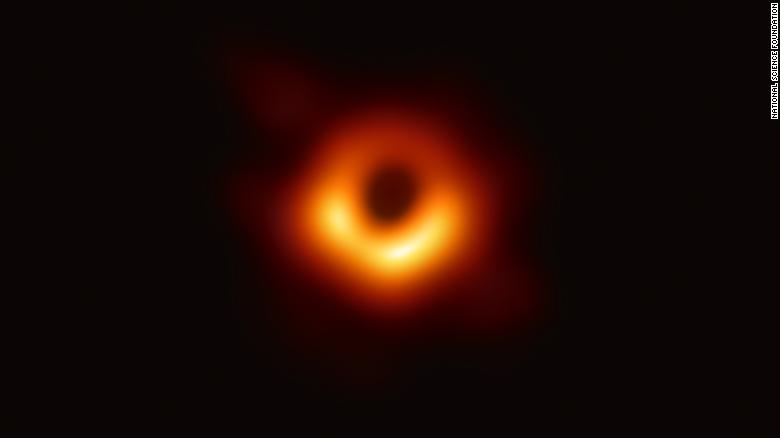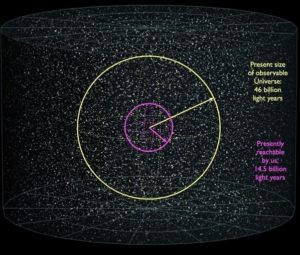
In part one I mentioned about the grandeur of time. How long time is and how our 100 years of human life is not even a blip on the scale of time. So is it worth being proud when we can influence some part of the space for some time? Next lets visit how big the space i.e. how big the universe is. With this realization hopefully we shall be prepared for the grand finale of the story of Indra (the king of gods) and ants.
For time I dipped into mythology. For universe let’s look at what science has to say about it.
How big is the universe?
Sorry wrong question!
Why?
Because this question makes no sense.
But why? What is the correct question?
Correct question is “How big is the observable universe?”
What does that mean?
The above is a conversation I had about three years back with the nephew of Nobel laureate Amartya Sen. I was fortunate enough to be a student of Prof Anindya Sen who is by far one of the most versatile polymath I know of. The rest of the article is my ignorance and Prof Sen’s intelligence guiding me towards light.
When I say light I don’t mean it just figuratively but rather literally. Light is the fastest thing in the universe. This we know from a certain legend called Einstein. It is rather non-trivial to prove why light is the fastest thing. Actually you can’t really prove why this is so. We just need to assume this is the case and when we assume this, rest of physics falls in line. The first hint of this came in 1887 in Michelson interferometer experiment where they accidentally observed what they were not hoping to – Speed of light is constant!
Short answer
The observable universe has a radius of 46 billion light years. This doesn’t mean that we can see up to 46 billion light years with our current technology. Rather this means that come what may and no matter how powerful our telescopes become, we can never see beyond 46 billion light years. Surprised?
Hubble Telescope is the most powerful telescope we have currently and it can see galaxies up to 14.5 billion light years away.
Long Answer
Now light-year is the distance which light, the fastest thing in our universe, can travel in one year. What 46 billion light years means is that if you start running at the speed of light (think of yourself sitting on a photon) then it will take 46 billion years to reach the edge of observable universe. But wait, didn’t I say the universe is 13.8 billion years old in my previous week’s writing? And we know that light is the fastest thing in the universe. Then shouldn’t the farthest object in the universe, since the big bang, be at maximum 13.8 billion light years away and not 46 billion light years away? Surely the farthest star could not have reached the edge of universe (what to say of observable universe) faster than light can reach there. Ah ha. Now we are talking. To understand this I will need to direct you to another ant and this is not Indra’s ant. I call this Anindya’s Ant.
The answer is that the universe itself is expanding and not just expanding but expanding at the rate faster than light can travel. What this means is that galaxies are going away from each other faster than light travels. How is that possible? Well, nothing in physics prohibits the space between galaxies itself to increase. Think of galaxies like dots on a balloon and someone (Brahma?) is blowing into that balloon such that the dots are getting further away from each other. And the rate at which this blowing up is happening is faster than the speed of light! This means if a light began from a far away galaxy to reach our galaxy Milky Way, it will never reach us because light is traveling at the speed of 300,000 km per second but the distance between the two galaxies is actually moving away faster than 300,000 km per second! Think of this like running towards right on a travelator moving left to catch your friend at the other end of the travelator. But the travelator is moving faster than the speed at which you can run. No matter how hard you try you can never reach your friend.
What the observable universe with radius of 46 billion light years means is that light which begins from the edge of observable universe will only reach to us 46 billion light years later. That galaxy itself will drift away and “fall off the edge of the observable universe” as it is moving away much faster than the speed of light. Every second we are actually seeing less and less of the universe – we are getting more and more lonely. Everything is moving away from us.
So what is beyond the observable universe? Probably galaxies identical to the ones we see in observable universe. But we shall never know because light (or any other signal including gravitational waves) from there can never reach us.
Are there other universes? What does that even mean? Yeah, possible. There is some research which says that there are multiverses. There is some research which says there are 11 dimensions and we live in the universe where 4 dimensions viz length, width, height and time are manifested (Recall a certain Brahma?) Other universes may have more dimensions.
It would not be totally wacky to think that indeed there are different universes created and destroyed by different Brahmas as Mahavishnu breathes in and out………Who knows?
Part 1: Why this ego? - Time
Part 2: Why this ego? - Space (Universe)
Part 3: Why this ego? – Indra and Ants: Confluence of Mythology, Science and Sociology
#Gyanalogy #Gyan #Ego #Time #Space #Universe #Indra #Ant #Pride #Gyana #Wisdom
To comment or receive more such wisdom, please register on www.gyanalogy.com/login




[…] Part 2: Why this ego? – Space (Universe) […]
[…] Part 2: Why this ego? – Space (Universe) […]